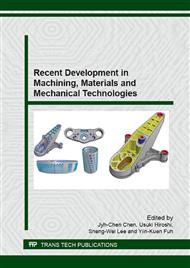p.151
p.158
p.164
p.168
p.174
p.180
p.185
p.191
p.198
Assessment of Geometrical Deviations of Machined Part by Using Coordinate Measuring Machines
Abstract:
Currently, geometric deviations of machined parts can be measured following the recommendations outlined in ISO standards such as ISO-12780, ISO-12781, ISO-12180 and ISO-12181. Coordinate measuring machines have now become widely used for inspection hence the tracing and probing strategies recommended in these standards have become much more important. Unfortunately, only minimum number of sections and points are mentioned. Generally, in each section, only a single point will be sampled for the inspection processes. However, the interval between each pair of sampling points has to be smaller than half of the wavelength of the machined surface. Hence, in this research, a method for determining a suitable number of sampling sections and points for geometrical deviation assessment of machined parts made from CNC machining centers is introduced. In this method, the wavelength of a machined surface is predicted from the results of tests used to assess machine performance. Using Finished Test Pieces in ISO 10791-7-A160 as a case study, experimental results indicated that the number of assessed sections and points, calculated according to the introduced method, can be used for accurate measurements of the geometrical deviations of machined parts.
Info:
Periodical:
Pages:
174-179
Citation:
Online since:
July 2015
Authors:
Price:
Сopyright:
© 2015 Trans Tech Publications Ltd. All Rights Reserved
Share:
Citation:


